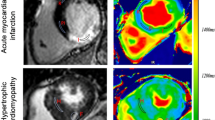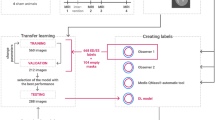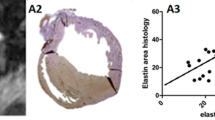Abstract
Aim:
To determine whether extracellular or intravascular contrast agents could detect chronic scarred myocardium in magnetic resonance imaging (MRI).
Methods:
Eighteen pigs underwent a 4 week ligation of 1 or 2 diagonal coronary arteries to induce chronic myocardial infarction. The hearts were then removed and perfused in a Langendorff apparatus. Eighteen hearts were divided into 2 groups. The hearts in groups I (n=9) and II (n=9) received the bolus injection of Gadolinium diethylenetriamine pentaacetic acid (Gd-DTPA, 0.05 mmol/kg) and gadolinium-based macromolecular agent (P792, 15 μmol/kg), respectively. First pass T2* MRI was acquired using a FLASH sequence. Delayed enhancement T1 MRI was acquired with an inversion recovery prepared TurboFLASH sequence.
Results:
Wash-in of both agents resulted in a sharp and dramatic T2* signal loss of scarred myocardium similar to that of normal myocardium. The magnitude and velocity of T2* signal recovery caused by wash-out of extracellular agents in normal myocardium was significantly less than that in scarred myocardium. Conversely, the T2* signal of scarred and normal myocardium recovered to plateau rapidly and simultaneously due to wash-out of intravascular agents. At the following equilibrium, extracellular agent-enhanced T1 signal intensity was significantly greater in scarred myocardium than in normal myocardium, whereas there was no significantly statistical difference in intravascular agent-enhanced T1 signal intensity between scarred and normal myocardium.
Conclusion:
After administration of extracellular agents, wash-out T2* first-pass and delayed enhanced T1 MRI could identify scarred myocardium as a hyperenhanced region. Conversely, scarred myocardium was indistinguishable from normal myocardium during first-pass and the steady state of intravascular agents.
Similar content being viewed by others
Log in or create a free account to read this content
Gain free access to this article, as well as selected content from this journal and more on nature.com
or
References
Kim RJ, Wu E, Rafael A, Chen EL, Parker MA, Simonetti O, et al. The use of contrast-enhanced magnetic resonance imaging to identify reversible myocardial dysfunction. N Engl J Med 2000; 343: 1445–53.
Choi KM, Kim RJ, Gubernikoff G, Vargas JD, Parker M, Judd RM . Transmural extent of acute myocardial infarction predicts long-term improvement in contractile function. Circulation 2001; 104: 1101–7.
McNamara MT, Higgins CB . Magnetic resonance imaging of chronic myocardial infarcts in man. AJR Am J Roentgenol 1986; 146: 315–20.
Arteaga C, Revel D, Zhao S, Hadour G, Forrat R, Oksendal A, et al. Myocardial “low reflow” assessed by Dy-DTPA-BMA-en-hanced first-pass MR imaging in a dog model. J Magn Reson Imaging 1999; 9: 679–84.
Choi SI, Jiang CZ, Lim KH, Kim ST, Lim CH, Gong GY, et al. Application of breath-hold T2-weighted, first-pass perfusion and gadolinium-enhanced T1-weighted MR imaging for assessment of myocardial viability in a pig model. J Magn Reson Imaging 2000; 11: 476–80.
Ambrosio G, Weisman HF, Mannisi JA, Becker LC . Progressive impairment of regional myocardial perfusion after initial restoration of postischemic blood flow. Circulation 1989; 80: 1846–61.
Kloner RA, Ganote CE, Jennings RB . The “no-reflow” phenomenon after temporary coronary occlusion in the dog. J Clin Invest 1974; 54: 1496–508.
Kroft LJ, Doornbos J, van der Geest RJ, de Roos A . Blood pool contrast agent CMD-A2-Gd-DOTA-enhanced MR imaging of infarcted myocardium in pigs. J Magn Reson Imaging 1999; 10: 170–7.
Arheden H, Saeed M, Higgins CB, Gao DW, Bremerich J, Wyttenbach R, et al. Measurement of the distribution volume of gadopentetate dimeglumine at echo-planar MR imaging to quantify myocardial infarction: comparison with 99mTc-DTPA auto-radiography in rats. Radiology 1999; 211: 698–708.
Tong CY, Prato FS, Wisenberg G, Lee TY, Carroll E, Sandler D, et al. Measurement of the extraction efficiency and distribution volume for Gd-DTPA in normal and diseased canine myocardium. Magn Reson Med 1993; 30: 337–46.
Schwitter J, Saeed M, Wendland MF, Derugin N, Canet E, Brasch RC, et al. Influence of severity of myocardial injury on distribution of macromolecules: extravascular versus intravascular gadolinium-based magnetic resonance contrast agents. J Am Coll Cardiol 1997; 30: 1086–94.
Bremerich J, Wendland MF, Arheden H, Wyttenbach R, Gao DW, Huberty JP, et al. Microvascular injury in reperfused infarcted myocardium: noninvasive assessment with contrast-enhanced echoplanar magnetic resonance imaging. J Am Coll Cardiol 1998; 32: 787–93.
Saeed M, van Dijke CF, Mann JS, Wendland MF, Rosenau W, Higgins CB, et al. Histologic confirmation of microvascular hyperpermeability to macromolecular MR contrast medium in reperfused myocardial infarction. J Magn Reson Imaging 1998; 8: 561–7.
Port M, Corot C, Rousseaux O, Raynal I, Devoldere L, Idee JM, et al. P792: a rapid clearance blood pool agent for magnetic resonance imaging: preliminary results. MAGMA 2001; 12: 121–7.
Taupitz M, Schnorr J, Wagner S, Kivelitz D, Rogalla P, Claassen G, et al. Coronary magnetic resonance angiography: experimental evaluation of the new rapid clearance blood pool contrast medium P792. Magn Reson Med 2001; 46: 932–8.
Simonetti OP, Kim RJ, Fieno DS, Hillenbrand HB, Wu E, Bundy JM, et al. An improved MR imaging technique for the visualization of myocardial infarction. Radiology 2001; 218: 215–23.
Wilke N, Simm C, Zhang J, Ellermann J, Ya X, Merkle H, et al. Contrast-enhanced first pass myocardial perfusion imaging: correlation between myocardial blood flow in dogs at rest and during hyperemia. Magn Reson Med 1993; 29: 485–97.
Saeed M, Wendland MF, Szolar D, Sakuma H, Geschwind JF, Globits S, et al. Quantification of the extent of area at risk with fast contrast-enhanced magnetic resonance imaging in experimental coronary artery stenosis. Am Heart J 1996; 132: 921–32.
Kim RJ, Chen EL, Lima JA, Judd RM . Myocardial Gd-DTPA kinetics determine MRI contrast enhancement and reflect the extent and severity of myocardial injury after acute reperfused infarction. Circulation 1996; 94: 3318–26.
White FC, Carroll SM, Magnet A, Bloor CM . Coronary collateral development in swine after coronary artery occlusion. Circ Res 1992; 71: 1490–500.
Roth DM, Maruoka Y, Rogers J, White FC, Longhurst JC, Bloor CM . Development of coronary collateral circulation in left circumflex Ameroid-occluded swine myocardium. Am J Physiol 1987; 253: H1279–88.
Kramer MF, Kinscherf R, Aidonidis I, Metz J, Kramer MF, Kinscherf R, et al. Occurrence of a terminal vascularisation after experimental myocardial infarction. Cell Tissue Res 1998; 291: 97–105.
Virag JI, Murry CE . Myofibroblast and endothelial cell proliferation during murine myocardial infarct repair. Am J Pathol 2003; 163: 2433–40.
Bulow H, Klein C, Kuehn I, Hollweck R, Nekolla SG, Schreiber K, et al. Cardiac magnetic resonance imaging: long term reproducibility of the late enhancement signal in patients with chronic coronary artery disease. Heart 2005; 91: 1158–63.
Ramani K, Judd RM, Holly TA, Parrish TB, Rigolin VH, Parker MA, et al. Contrast magnetic resonance imaging in the assessment of myocardial viability in patients with stable coronary artery disease and left ventricular dysfunction. Circulation 1998; 98: 2687–94.
Rehwald WG, Fieno DS, Chen EL, Kim RJ, Judd RM . Myocardial magnetic resonance imaging contrast agent concentrations after reversible and irreversible ischemic injury. Circulation 2002; 105: 224–9.
Morales C, Gonzalez GE, Rodriguez M, Bertolasi CA, Gelpi RJ . Histopathologic time course of myocardial infarct in rabbit hearts. Cardiovasc Pathol 2002; 11: 339–45.
Dobaczewski M, Bujak M, Zymek P, Ren G, Entman ML, Frangogiannis NG . Extracellular matrix remodeling in canine and mouse myocardial infarcts. Cell Tissue Res 2006; 22: 475–88.
Author information
Authors and Affiliations
Corresponding authors
Rights and permissions
About this article
Cite this article
Wang, J., Liu, Hy., Lü, H. et al. Identification of chronic myocardial infarction with extracellular or intravascular contrast agents in magnetic resonance imaging. Acta Pharmacol Sin 29, 65–73 (2008). https://doi.org/10.1111/j.1745-7254.2008.00656.x
Received:
Accepted:
Issue date:
DOI: https://doi.org/10.1111/j.1745-7254.2008.00656.x
Keywords
This article is cited by
-
Kardiovaskuläre Toxizität der Therapie onkologischer Erkrankungen bei Kindern und Jugendlichen
Monatsschrift Kinderheilkunde (2024)
-
Quantitative Tissue Characterization in Pediatric Cardiology
Current Cardiovascular Imaging Reports (2017)
-
Collateral circulation formation determines the characteristic profiles of contrast-enhanced MRI in the infarcted myocardium of pigs
Acta Pharmacologica Sinica (2015)
-
T 90 Measurement of Co-C, Pt-C, and Re-C High-Temperature Fixed Points at the NIM
International Journal of Thermophysics (2011)



